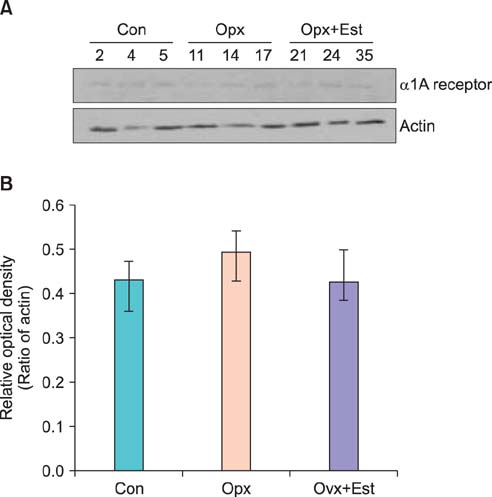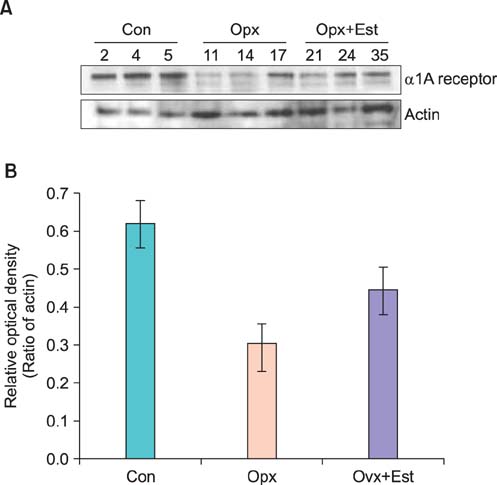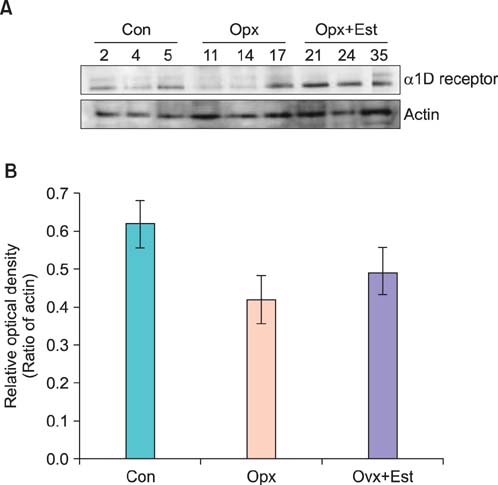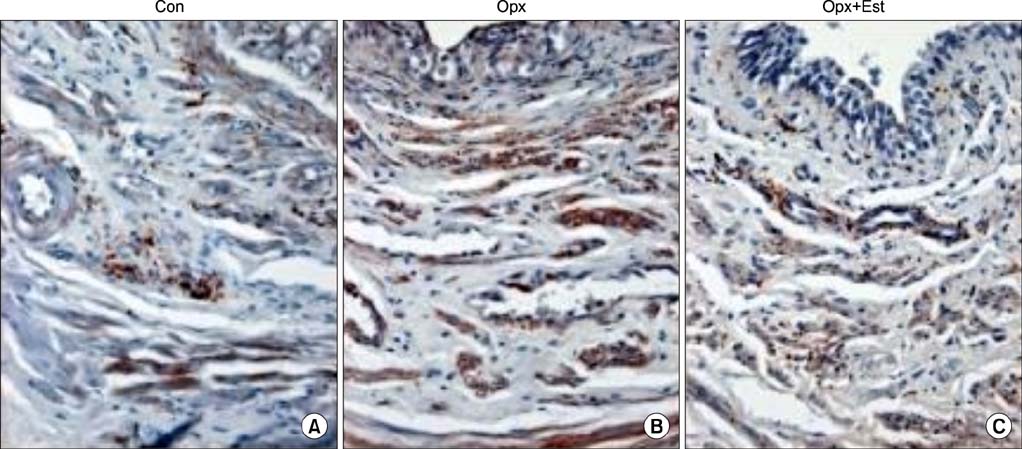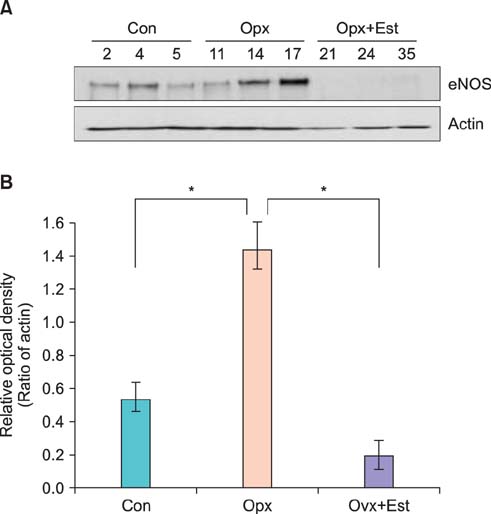Korean J Urol.
2014 Oct;55(10):677-686. 10.4111/kju.2014.55.10.677.
Expression of alpha1 Receptor and Nitric Oxide Synthase in Oophorectomized and Estrogen-Supplemented Rat Bladder and Urethra
- Affiliations
-
- 1Department of Urology, Busan Veterans Hospital, Busan, Korea.
- 2Research Institute for Convergence of Biomedical Science and Technology, Pusan National University Yangsan Hospital, Yangsan, Korea. lsd@pusan.ac.kr
- 3Department of Urology, Pusan National University Yangsan Hospital, Pusan National University School of Medicine, Yangsan, Korea.
- KMID: 2069792
- DOI: http://doi.org/10.4111/kju.2014.55.10.677
Abstract
- PURPOSE
To investigate the effects of estrogen on the expression of the alpha1 receptor and nitric oxide synthase (NOS) in rat urethra and bladder after oophorectomy.
MATERIALS AND METHODS
Forty-five mature female Sprague-Dawley rats (aged 10-11 weeks, 235-250 g) were randomly assigned to one of three groups: control group, oophorectomy group (Opx), or oophorectomy and estradiol replacement group (Opx+ Est). The degree of expression of alpha1 receptor (alpha1A and D) and NOS (neuronal NOS [nNOS] and endothelial NOS [eNOS]) in bladder and urethral tissues was investigated by using immunohistochemical staining and Western blotting.
RESULTS
In the bladder, the expression rates of alpha1 receptor (alpha1A and alpha1D) increased in the Opx group but decreased in the Opx+Est group. These changes were not statistically significant. The alpha1A and alpha1D receptor of the urethra decreased in the Opx group but increased in the Opx+Est group. These changes were not statistically significant. In the bladder and urethra, the expression rates of nNOS and eNOS significantly increased in the Opx group but decreased in the Opx+Est group (p<0.05).
CONCLUSIONS
These data suggest that estrogen depletion increases NOS and alpha1 receptor expression in the rat bladder. However, these changes could be restored by estrogen replacement therapy.
Keyword
MeSH Terms
-
Animals
Collagen/metabolism
Estradiol/analogs & derivatives/blood/pharmacology
Estrogen Replacement Therapy/*methods
Female
Muscle, Smooth/pathology
Nitric Oxide Synthase/*metabolism
Ovariectomy
Rats, Sprague-Dawley
Receptors, Adrenergic, alpha-1/*metabolism
Urethra/drug effects/*metabolism/pathology
Urinary Bladder/drug effects/*metabolism/pathology
Collagen
Estradiol
Nitric Oxide Synthase
Receptors, Adrenergic, alpha-1
Figure
Reference
-
1. Takahashi W, Yoshida M, Wada Y, Goto S, Inadome A, Yono M, et al. Effect of estrogen on nitric oxide-induced relaxation of the rabbit urethra. Eur J Pharmacol. 1997; 339:165–171.2. Morrison JF. The functions of efferent nerves to the lower urinary tract. In : Torrens M, Morrison JF, editors. The physiology of the lower urinary tract. London: Springer;1987. p. 133–159.3. Seguchi H, Nishimura J, Zhou Y, Niiro N, Kumazawa J, Kanaide H. Expression of beta3-adrenoceptors in rat detrusor smooth muscle. J Urol. 1998; 159:2197–2201.4. Maggi CA, Santicioli P, Furio M, Meli A. Dual effects of clonidine on micturition reflex in urethane anesthetized rats. J Pharmacol Exp Ther. 1985; 235:528–536.5. Hampel C, Dolber PC, Smith MP, Savic SL, Throff JW, Thor KB, et al. Modulation of bladder alpha1-adrenergic receptor subtype expression by bladder outlet obstruction. J Urol. 2002; 167:1513–1521.6. Dokita S, Morgan WR, Wheeler MA, Yoshida M, Latifpour J, Weiss RM. NG-nitro-L-arginine inhibits non-adrenergic, noncholinergic relaxation in rabbit urethral smooth muscle. Life Sci. 1991; 48:2429–2436.7. Hashimoto S, Kigoshi S, Muramatsu I. Nitric oxide-dependent and -independent neurogenic relaxation of isolated dog urethra. Eur J Pharmacol. 1993; 231:209–214.8. Leone AM, Wiklund NP, Hokfelt T, Brundin L, Moncada S. Release of nitric oxide by nerve stimulation in the human urogenital tract. Neuroreport. 1994; 5:733–736.9. Yallampalli C, Byam-Smith M, Nelson SO, Garfield RE. Steroid hormones modulate the production of nitric oxide and cGMP in the rat uterus. Endocrinology. 1994; 134:1971–1974.10. Jackson SL, Fihn SD. Exogenous estrogen and urinary incontinence. J Urol. 2009; 181:1989–1991.11. Chen B, Yeh J. Alterations in connective tissue metabolism in stress incontinence and prolapse. J Urol. 2011; 186:1768–1772.12. Hextall A, Cardozo L. The role of estrogen supplementation in lower urinary tract dysfunction. Int Urogynecol J Pelvic Floor Dysfunct. 2001; 12:258–261.13. Grady D, Brown JS, Vittinghoff E, Applegate W, Varner E, Snyder T, et al. Postmenopausal hormones and incontinence: the Heart and Estrogen/Progestin Replacement Study. Obstet Gynecol. 2001; 97:116–120.14. Moehrer B, Hextall A, Jackson S. Oestrogens for urinary incontinence in women. Cochrane Database Syst Rev. 2003; (2):CD001405.15. Beisland HO, Fossberg E, Moer A, Sander S. Urethral sphincteric insufficiency in postmenopausal females: treatment with phenylpropanolamine and estriol separately and in combination. A urodynamic and clinical evaluation. Urol Int. 1984; 39:211–216.16. Dmitrieva N. Increased alpha1-adrenergic activity in the rat bladder by depletion of ovarian hormones. J Urol. 2007; 178:2677–2682.17. Rand MJ, Li CG. Discrimination by the NO-trapping agent, carboxy-PTIO, between NO and the nitrergic transmitter but not between NO and EDRF. Br J Pharmacol. 1995; 116:1906–1910.18. Bennett BC, Kruse MN, Roppolo JR, Flood HD, Fraser M, de Groat WC. Neural control of urethral outlet activity in vivo: role of nitric oxide. J Urol. 1995; 153:2004–2009.19. Ho MH, Bhatia NN, Khorram O. Physiologic role of nitric oxide and nitric oxide synthase in female lower urinary tract. Curr Opin Obstet Gynecol. 2004; 16:423–429.20. Okuno T, Masuda H, Tsujii T, Kihara K, Yamauchi Y, Azuma H. Accumulated endogenous nitric oxide synthase inhibitors in inhibiting urethral relaxation following estrogen supplementation in ovariectomized rabbits. J Urol. 2004; 172:360–364.
- Full Text Links
- Actions
-
Cited
- CITED
-
- Close
- Share
- Similar articles
-
- The Effect of Estrogen on Expression of Neuronal and Endothelial Nitric Oxide Synthase and on Histologic Composition in Rat Bladder and Urethra
- Involvement of Fibronectin in the Migration of Macrophage and Expression of Nitric Oxide Synthase in the BCG induced Inflammatory Sites in Rat Bladder
- Role of Nitric Oxide in Proximal Urethral Relaxation of the Rat
- Expression of Constitutive Nitric Oxide Synthase by Gastrointestinal Epithelial Cells
- Alteration of Nitric Oxide Synthase Subtype Expression in Contralateral Testis of Rat in Response to Unilateral Testicular Torsion Followed by Detorsion

